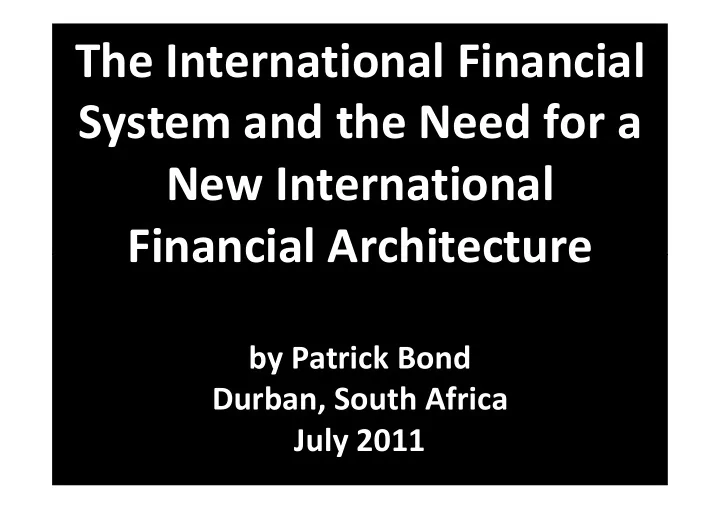

The International Financial System and the Need for a New International Financial Architecture Financial Architecture by Patrick Bond Durban, South Africa July 2011
Sovereign debt defaults, 1820-1999: percent of national states
Evolution of international financial architectures Date System Reserve Asset(s) Leader(s) 1803-1873 Bimetallism Gold & Silver France 1873-1914 Gold Standard Gold and £ Britain 1915-1924 Anchored $ St. Gold and $ US 1924-1933 Gold Standard Gold,$ and £ US, UK, France 1934-1971 1934-1971 Anchored $ St. Anchored $ St. Gold and $ Gold and $ US, G-10 US, G-10 1971-1973 Dollar Standard $ US 1973-1985 Flex. Ex. Rates $, DM, £, US, FRG 1985-1999 Man. Ex. Rates $, DM, ¥ US 1999-2010 Dollar and Euro $, €, ¥, £ US EMU 2010-? Currency Areas $. €, ¥, C¥, £ US, EMU Source: R. Mundell, ‘Euro in a New International Financial Architecture’, May 27, 2010, Joint EBF - ABA Conference: “Inter-Regional Banking Cooperation for Solid Financial Future” in Baku, Azerbaijan
Degree of international financial integration High 2000 Gold Standard 1880–1914 1914 1900 Float 1971–2000 [1] 1929 Bretton Woods 1880 1945–71 1980 1860 1925 1971 1918 1960 Interwar 1914–45 1945 Low 1860 1880 1900 1920 1940 1960 1980 2000 Source: Stijn Claessens and Maurcie Obstfelt
Dollar in decline dollar volatility, 2000s panic of late 2008
Dubious statistics: Correcting the GDP bias (global) Source: redefiningprogress.org
root ‘overaccumulation’ process: source of declining US profits during globalisation/financialisation era US corporate profits derived much less from manufacturing products; much greater sources of profits came from abroad; profits also came more from returns on financial assets. Source: Gerard Dumenil and Dominique Levy
Real interest rate rise with Volcker as Federal Reserve chair “Volcker was selected [as Fed chair in 1979] because he was the candidate of Wall Street. This was their price, in effect.” – Jimmy Carter’s domestic policy advisor Stuart Eizenstat VOLCKER SHOCK Source: Gerard Duminil and Dominique Levy
investment by US private capital because of overinvestment, overinvestment, subsequent investment drought from early 1980s late 1990s was mainly IT, especially software (source: John Bellamy Foster and Fred Magdoff, 2009)
overaccumulation of capital remained through 1980s-2000s (source: John Bellamy Foster and Fred Magdoff, 2009)
US economy becomes debt- addicted from early 1980s (source: John Bellamy Foster and Fred Magdoff, 2009 )
US corporate profits become finance-addicted in mid-1980s (source: John Bellamy Foster and Fred Magdoff, 2009)
‘hollowing corporations’, mid-1980s (source: John Bellamy Foster and Fred Magdoff, 2009)
How US economy fooled economists and investors for 20 years • Low interest rate • Low inflation rate • Low unemployment source: US Fed, Gagnon, 2009
How US economy fooled economists and investors for 20 years • steady GDP • rising stock market • recovery from currency volatility volatility source: US Fed, Gagnon, 2009
Production crash in historical terms Initially as bad as 1929 Source: Eichengreen and O’Rourke
Trade crash in historical terms A worse crisis than Initially worse than 1929! 1929 Source: Eichengreen and O’Rourke
Stock market crash in historical terms Initially worse than 1929 Source: Eichengreen and O’Rourke
Commodity devaluations: Change in prices, July – December 2008 Source: Unctad, The Global Economic Crisis, May 2009
Crash of GDP, industrial production and FDI Source: The Economist
Source: IMF, Global Financial Stability Report , April 2010
first US Fed bailout (‘Quantitative Easing’) in (‘Quantitative Easing’) in the 2008-present crisis (source: US Federal Reserve, 2010)
Source: IMF, Global Financial Stability Report , April 2010
Recommend
More recommend